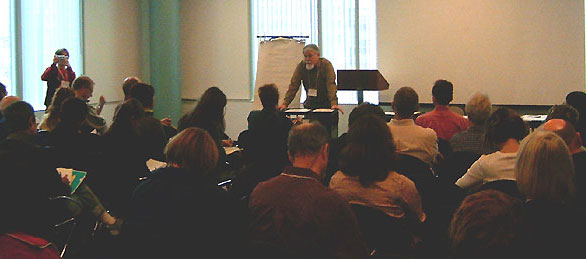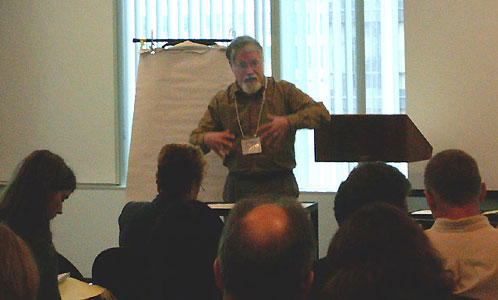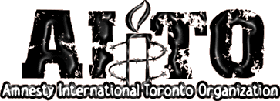Amnesty International Toronto Organization
Regional Meeting October 16,
2004
Workshop outline – Amnesty in
100 Seconds
Michael
Craig
|
I will be assisted by Rosemary Parker and Donna Abs.
Workshop Outline Michael Craig • October 2004 |
 |
[The primary presentation methods will be questions and answers – pulling most of the logical conclusions from the audience – plus workshop simulations.]
Inroduction
1. When and why do you have brief encounters or discussions about Amnesty and
h.r.?
• Public tables; petition drives; social occasions
2. How do brief encounters differ from a 20-minute speech or Q & A session?
• Probably not much – the goal is generally the same, though the timeline is
quite different.
3. What are the Goals and Priorities of any presentation about Amnesty
and human rights?
• Action objective – What do you want this person to do?
• Attitude change –
Be concerned enough about h.r. to take action;
understand and respect Amnesty;
acknowledge that good is happening along with the bad, that Amnesty does make a
difference.
N.B. – Don’t take it for granted that AI is universally understood and respected.
4. What do you have to know or be aware of in order to have a significant
impact on your subject?
• Who is this person (ethnicity, age, education profile; what they know
about AI)
• What attitudes and knowledge will you often encounter among immigrants and
refugees (people with accents) in Canada?
o Many know
little or nothing about Amnesty, so a brief definition is required.
o Some, from
high-abuse countries, know and respect Amnesty.
o Some, from
countries like Turkey, are skeptical about Amnesty claims of h.r. abuses in
their country; their controlled media has never told them the truth.
• What can you say that will motivate them to take action on human rights?
• What biases or cynicism prevents this person (most people) from
taking Amnesty and h.r. seriously? (See Questions below.)
Brief Encounters about Amnesty – the unstructured kind
1. Unstructured or in casual conversation – what do you want to achieve?
• Make, not lose, a friend
• Define Amnesty – mandate and methods – very briefly
• Answer questions: what does this person/group know or need to know?
• Encourage your listener to support Amnesty and take action
2. What skills or knowledge – the absolute basic – do you need?
• Think in terms of the information and structuring that
information!
• Brief definitions of Amnesty mission and methods
• WHO is Amnesty?
professionals (the I.S. and Section staff)
Non-governmental, non-corporate, non-religious, independent, impartial
• WHY is Amnesty effective?
accurate, comprehensive, unassailable
3. How much can (or should) be said in 100 seconds? Assuming that your listener
knows little or nil about Amnesty, can you construct a few sentences to cover
the essence, the questions above?
4. How can you structure such a conversation in your head? Use key words:
mandate
methods
reliability-credibility
action
Don’t forget: Ask questions to find out what your listener wants to know.
Workshop simulation: social conversations about Amnesty and h.r.
• Break up into groups of four
• One person throws out a question about human rights or a comment about (e.g.)
the current situation in Darfur or Colombia or whatever. They may follow up
with a pointed question or obvious skepticism (though negatives are seldom so
explicit).
• In turn each person responds with the objective of informing and
motivating the others.
• Evaluation. how do we do at:
defining Amnesty;
explaining why we should all be concerned;
convincing people that progress is possible and Amnesty makes a difference;
introducing an action option?
 Structured encounters – mostly tables with info and petitions
Structured encounters – mostly tables with info and petitions
1.Objectives? See above. essentially to:
alert someone to a particular h.r. situation,
get a signature on a petition and
encourage further interest in Amnesty.
2. How do you pull people in, get them interested, encourage action?
• Don’t just stand there at your table: do something!
• Be pleasant, good-humoured, friendly and assertive as you pull people
in. Try to catch their eye.
• Be yourself: I’m casual, gregarious, intense; but it’s just as good to be
calm and formal while still being friendly and assertive.
• Start with a question-invitation of approx a dozen words:
“Hi, do you have a moment to sign a petition concerning human rights abuses in
Honduras?”
• As you’re walking to the table, follow up with one or two sentences, about
the specific petition or h.r. atrocity that you are featuring – often simply
from the wording of the petition.
(N.B. You seldom need detailed information, so don’t be deterred by how little
you know. If need be, tell people how they can find the details at amnesy.ca.)
• Try to humanize it: use the background info or the petition itself to refer
to a particular person or group that has been targeted.
Workshop simulation: Amnesty table situation, collecting petition
signatures
• same four groups: in turn, each person plays the role of the AI
person at the table who approaches another person – the uninformed general
public.
• The target person (being asked to sign) should throw out an objection (though
people seldom do)
• Again (from above) what is the goal of this encounter?
• What are the key things to say?
• Evaluation. how did we do at:
speaking clearly
projecting a friendly, unthreatening image
getting people to come to sign the petition
following up with a few sentences about the h.r. issue
asking if the subject wants more info, about Amnesty or whatever
Dealing with Tough Questions and Skepticism [We'll try to make time
to cover this topic.]
1. Not all tough questions get asked: people are too polite. However,
many people do have legitimate questions or objections about Amnesty’s work
and, if time permits, it is often useful to address these areas of concern.
See handout: “Questions, Questions – Asked and Unasked”
2. Three most common questions and areas of skepticism (details on handout)
• It’s all hopeless . . .
• I don’t believe you … or I don’t give a damn
• Why don’t you . . .
3. General approach to handling tough questions and skepticism
• Ask a question to clarify the question or concern.
• Explain Amnesty’s mandate – and how it pertains to the questioner’s concern.
• Emphasize that Amnesty reports on h.r. abuses in every country, not
just the third world.
• Repeat the mantra: Amnesty is impartial, independent, accurate!
• Encourage people to take the long-term view: look at h.r. improvements
in countries like Argentina, Chile and eastern Europe, e.g. Poland – even
Greece and Portugal
• Refer to Amnesty’s “Good News Stories” on the net.
• Talk up our website: suggest that people do research at amnesty.ca or amnesty.org.
